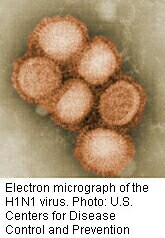
TUESDAY, April 13 (HealthDay News) — Researchers in Singapore report that those serving in the military and young adults showed higher rates of infection with the H1N1 flu during the epidemic last year.
Almost 30 percent of military personnel, who tend to be younger, appear to have been infected, versus 13.5 percent in the general population, 6.5 percent of hospital employees and 1.2 percent of those in long-term care facilities, the researchers found.
Interestingly, only 13 percent of the overall study sample was infected, leaving the remaining 87 percent still vulnerable to the virus, the study authors noted.
“In this group of individuals, only 13 percent got infected,” said Dr. Kenneth Bromberg, chairman of pediatrics at The Brooklyn Hospital Center in New York City. “We can’t say why, but this population will need to be vaccinated [this year] because they’re not really immune to H1N1.”
“The fact that large numbers remain susceptible means that it’s still worthwhile to vaccinate adults after the initial wave,” added Mark I.C. Chen, lead author of the report appearing in the April 14 issue of the Journal of the American Medical Association.
The H1N1 virus first appeared last April in the Northern Hemisphere. It was detected in Singapore, a tiny nation-state on the equator, in May of 2009 and became epidemic there from late June 2009 through early August 2009.
In their study, Chen and colleagues measured changes in antibody levels in blood samples from four groups of people: the general population, military personnel, staff at an acute-care hospital, and staff and residents of long-term care facilities between June 22, 2009 and Oct. 15, 2009.
High rates of infection in the military could be due to crowded living conditions, as well as gender (males tend to be more susceptible to respiratory and stomach viruses) and younger age, said Dr. Dean Blumberg, an associate professor of pediatric infectious diseases at University of California, Davis, Children’s Hospital.
People in households where other people had been infected with H1N1 had triple the risk of infection compared with the general population. On the other hand, older people were less likely to be infected, as were people who had existing antibodies.
Why would some people have existing antibodies to an entirely new viral strain? Several reasons, said Chen, who is an associate consultant at Singapore’s Tan Tock Seng Hospital. “Some individuals vaccinated [with the seasonal influenza vaccine] developed antibodies to H1N1-2009,” he said. “Another is the imperfect specificity of the test for influenza antibodies.”
Individuals may also have been infected with older strains of influenza (notably one circulating in 1957-1958), which could have conferred protection against H1N1.
Hospital workers may have been protected through various infection-control measures, such as wearing masks, and patient and visitor screening before entering facilities, the authors stated.
The study did not include information on the spread of the virus in children, which could represent a major drawback.
“We believe that the key players in the outbreak were children,” Bromberg said.
And there’s some question as to whether the results are applicable to the United States, although Chen believes they are.
“I believe the general finding that large numbers of adults remain susceptible should be broadly applicable,” he said. “However, several differences in the population studied should be noted. For instance, the U.S. had two epidemic waves (spring-summer and autumn-winter), while we had one.”
“The question is what’s going to happen next winter,” Blumberg said. “Is the virus going to be worse, the same, is it going to be better? We don’t know and, on the basis of past epidemics, it’s very hard to predict.”
More information
The U.S. Centers for Disease Control and Prevention has more on H1N1.

